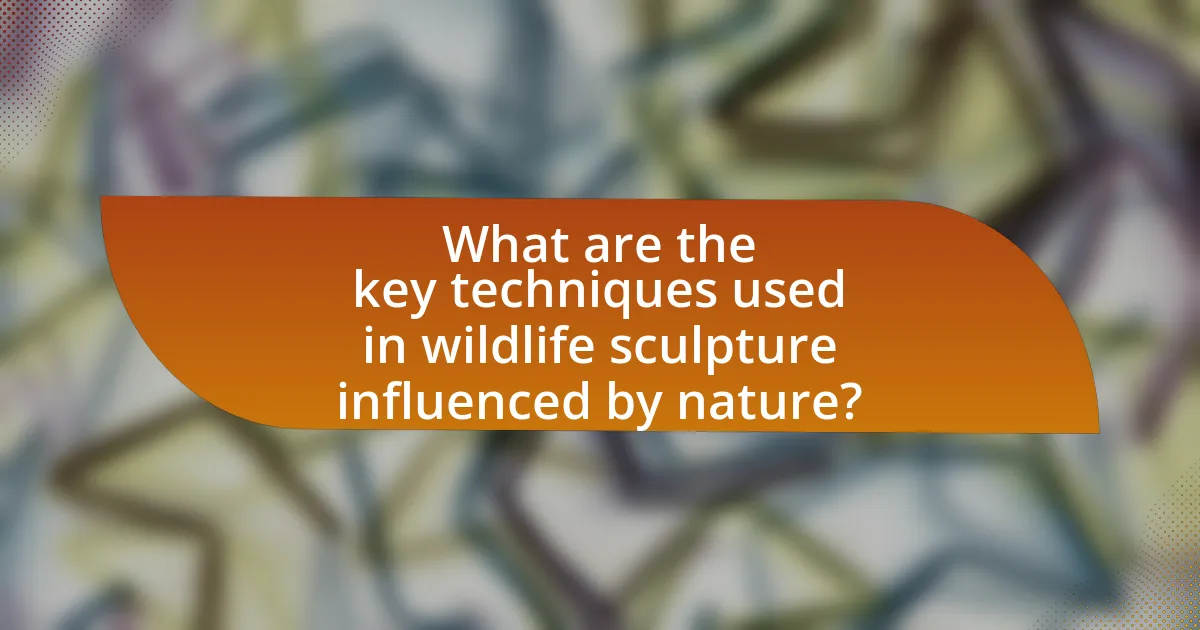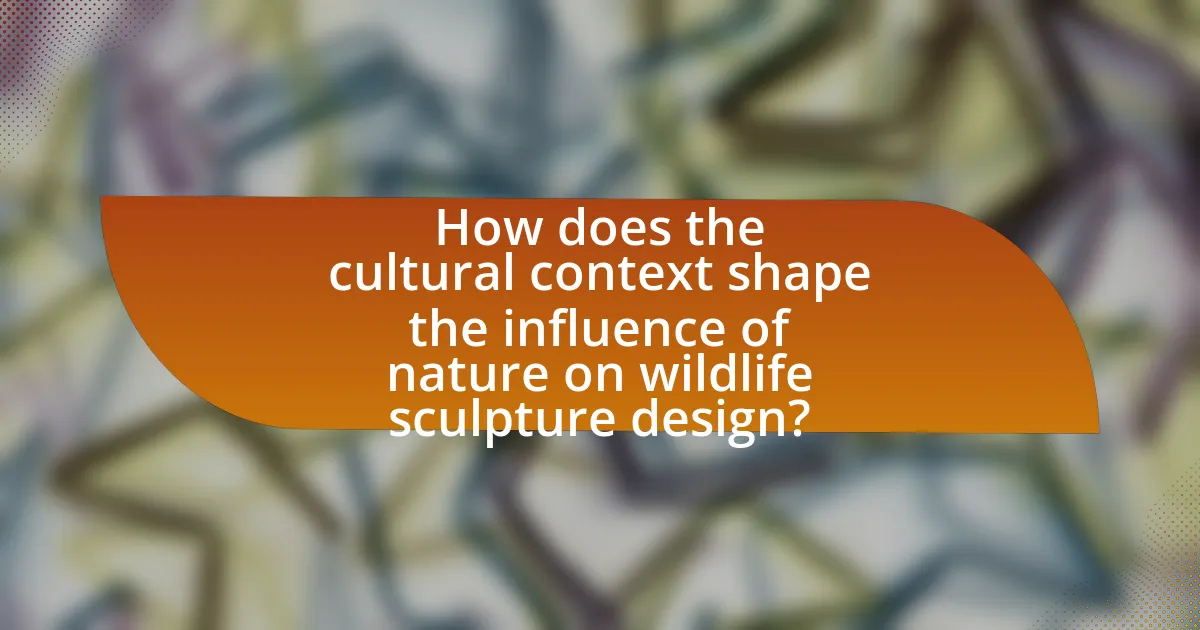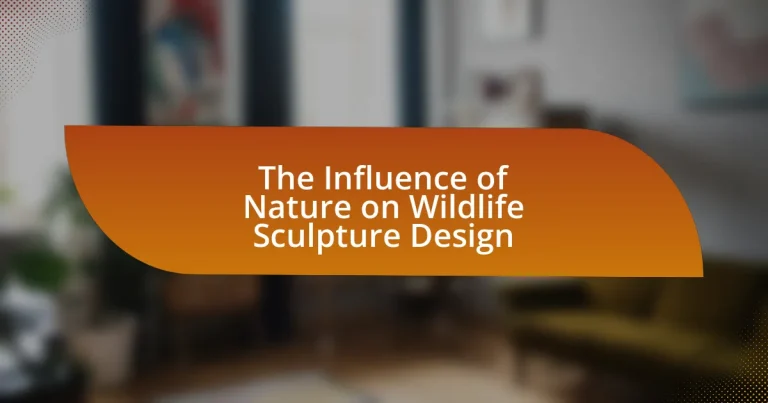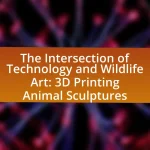The article examines the significant influence of nature on wildlife sculpture design, highlighting how artists draw inspiration from animal forms, behaviors, and habitats. It discusses the importance of direct observation and understanding of anatomy in creating realistic representations, as well as the role of natural materials in enhancing the authenticity of sculptures. Key techniques, cultural contexts, and contemporary environmental issues are explored, illustrating how these factors shape artistic expression and promote conservation awareness. The article emphasizes best practices for emerging artists to develop their skills in wildlife sculpture through observation, material selection, and engagement with the art community.

What is the Influence of Nature on Wildlife Sculpture Design?
Nature significantly influences wildlife sculpture design by providing inspiration through the forms, textures, and behaviors of animals and their habitats. Artists often study the anatomical details and natural environments of wildlife to create realistic and expressive representations. For instance, the intricate patterns of a bird’s feathers or the muscular structure of a mammal can dictate the sculptural techniques and materials used, such as clay or bronze. Additionally, the ecological context, including the flora surrounding wildlife, informs the composition and setting of the sculptures, enhancing their authenticity and emotional impact. This relationship between nature and sculpture is evident in the works of renowned sculptors like Henry Moore, who drew from natural forms, and contemporary artists who emphasize environmental themes in their wildlife representations.
How does nature inspire wildlife sculpture artists?
Nature inspires wildlife sculpture artists by providing them with direct observations of animal forms, behaviors, and habitats. Artists often study the intricate details of wildlife, such as fur texture, muscle structure, and movement, which they translate into their sculptures. For instance, renowned wildlife sculptor Robert Glen has emphasized the importance of field studies in capturing the essence of animals, stating that understanding their natural environment enhances the authenticity of the artwork. This connection to nature not only informs the physical representation but also evokes emotional responses, allowing viewers to appreciate the beauty and complexity of wildlife.
What specific elements of nature are commonly reflected in wildlife sculptures?
Wildlife sculptures commonly reflect elements such as animals, plants, landscapes, and natural textures. These elements are integral to capturing the essence of wildlife and their habitats. For instance, sculptures often depict specific animal species in realistic poses, showcasing their physical characteristics and behaviors. Additionally, the inclusion of flora, such as trees and flowers, enhances the context of the animal’s environment. Landscapes, including mountains, rivers, and forests, provide a backdrop that situates the wildlife within its natural setting. Natural textures, like fur, feathers, and bark, are also emphasized to create a lifelike representation. This focus on nature’s elements not only highlights biodiversity but also fosters a deeper appreciation for the interconnectedness of life.
How do different environments influence the style of wildlife sculptures?
Different environments significantly influence the style of wildlife sculptures by dictating the materials, forms, and themes artists choose to represent. For instance, sculptures created in coastal regions often incorporate marine elements and utilize materials like driftwood or stone, reflecting the local ecosystem. In contrast, sculptures from forested areas may emphasize terrestrial animals and use wood or clay, showcasing the biodiversity of that environment. Additionally, the cultural context of the environment shapes artistic expression; for example, Indigenous artists may draw on traditional stories and symbols related to local wildlife, resulting in unique stylistic choices. This relationship between environment and artistic style is evident in the works of artists like Andy Goldsworthy, who uses natural materials found in specific locales to create site-specific sculptures that resonate with their surroundings.
Why is understanding nature important for wildlife sculpture design?
Understanding nature is crucial for wildlife sculpture design because it enables artists to accurately represent the anatomy, behavior, and habitat of animals. This knowledge ensures that sculptures are not only aesthetically pleasing but also biologically and ecologically correct, which enhances the viewer’s appreciation and understanding of wildlife. For instance, artists who study animal movements and environments can create more dynamic and lifelike representations, as seen in the works of renowned wildlife sculptors like Robert Bateman, who emphasizes realism in his pieces. Such accuracy fosters a deeper connection between the audience and the natural world, promoting conservation awareness and appreciation for biodiversity.
How does a deep connection with nature enhance artistic expression?
A deep connection with nature enhances artistic expression by providing artists with authentic inspiration and emotional depth. This connection allows artists to observe and interpret the intricate details of the natural world, leading to more vivid and relatable representations in their work. Research indicates that exposure to natural environments can stimulate creativity and improve mood, which in turn fosters innovative artistic ideas. For instance, a study published in the Journal of Environmental Psychology found that individuals who spent time in nature exhibited increased levels of creativity and problem-solving skills. This evidence supports the notion that a profound relationship with nature not only enriches the artist’s perspective but also translates into more impactful and resonant artistic expressions.
What role does observation of wildlife play in sculpture design?
Observation of wildlife plays a crucial role in sculpture design by providing artists with accurate anatomical details, behavioral insights, and emotional expressions of animals. This direct observation allows sculptors to create more lifelike and relatable representations, enhancing the viewer’s connection to the artwork. For instance, renowned sculptor Henry Moore often studied animals in their natural habitats, which informed his abstract forms and emphasized the essence of movement and form in his sculptures. Such practices demonstrate that careful observation leads to a deeper understanding of wildlife, ultimately resulting in more authentic and impactful sculpture designs.

What are the key techniques used in wildlife sculpture influenced by nature?
The key techniques used in wildlife sculpture influenced by nature include direct observation, natural materials, and anatomical accuracy. Direct observation allows sculptors to study animals in their habitats, capturing their forms and behaviors accurately. Utilizing natural materials, such as wood, stone, or clay, enhances the connection to the environment and reflects the textures and colors found in nature. Anatomical accuracy is crucial, as it ensures that the sculptures represent the physical characteristics of the animals realistically, which is often achieved through detailed research and reference to biological studies. These techniques collectively contribute to creating lifelike representations that resonate with the essence of wildlife.
How do artists incorporate natural materials into their sculptures?
Artists incorporate natural materials into their sculptures by utilizing elements such as wood, stone, clay, and metal sourced from the environment. This practice allows artists to create works that reflect the organic forms and textures found in nature, enhancing the connection between the artwork and its natural inspiration. For instance, sculptors like Andy Goldsworthy use materials like leaves, stones, and ice to create site-specific installations that emphasize the transient beauty of nature. Additionally, the use of natural materials often aligns with sustainable art practices, as artists seek to minimize their environmental impact by sourcing locally and using biodegradable or recyclable materials. This approach not only enriches the aesthetic quality of the sculptures but also fosters a deeper appreciation for the natural world.
What types of materials are most commonly used in nature-inspired wildlife sculptures?
Nature-inspired wildlife sculptures commonly utilize materials such as bronze, stone, wood, and clay. Bronze is favored for its durability and ability to capture fine details, making it a popular choice for lifelike representations. Stone, including marble and granite, is often used for its permanence and natural aesthetic, allowing artists to create robust and timeless pieces. Wood is appreciated for its organic feel and versatility, enabling intricate carvings that reflect the beauty of nature. Clay is frequently employed for its malleability, allowing for detailed modeling and easy manipulation during the sculpting process. These materials collectively enhance the artistic expression of wildlife sculptures, aligning with the natural themes they represent.
How does the choice of material affect the final design of the sculpture?
The choice of material significantly influences the final design of a sculpture by determining its aesthetic qualities, structural integrity, and the techniques used in its creation. For instance, materials like marble allow for fine detail and smooth finishes, which can enhance the realism in wildlife sculptures, while metals such as bronze provide durability and the ability to create dynamic poses through casting techniques. Additionally, the weight and texture of the material can affect the sculpture’s placement and interaction with its environment, as seen in outdoor installations where weather-resistant materials are preferred. Historical examples include the use of Carrara marble in classical sculptures, which is renowned for its ability to capture intricate details, and the use of recycled materials in contemporary art, which reflects environmental themes and sustainability.
What sculpting techniques are influenced by natural forms?
Sculpting techniques influenced by natural forms include organic modeling, bas-relief, and subtractive carving. Organic modeling allows artists to create fluid, natural shapes that mimic the contours of living organisms, often resulting in sculptures that evoke a sense of movement and life. Bas-relief techniques involve carving images into a flat surface, drawing inspiration from natural textures and patterns found in flora and fauna, which enhances the visual depth and realism of the artwork. Subtractive carving, where material is removed to reveal the form within, often reflects the natural shapes and structures of stones and wood, emphasizing the inherent qualities of the materials used. These techniques are validated by historical practices in cultures that have long drawn inspiration from their natural surroundings, such as the ancient Greeks and Indigenous peoples, who incorporated elements of nature into their sculptural works.
How do artists replicate the textures and forms found in nature?
Artists replicate the textures and forms found in nature by employing techniques such as observation, material selection, and sculptural methods. They closely study natural elements, analyzing the intricacies of surfaces and shapes, which informs their artistic choices. For instance, artists may use clay, stone, or metal to mimic the tactile qualities of natural materials, while techniques like carving, modeling, or casting allow them to recreate the three-dimensional aspects of their subjects. Historical practices, such as the use of direct observation in the Renaissance, demonstrate that artists have long relied on nature as a primary reference, ensuring accuracy and authenticity in their work.
What tools and methods are essential for achieving realistic wildlife representations?
To achieve realistic wildlife representations, essential tools and methods include high-quality reference materials, sculpting tools, and digital modeling software. Reference materials, such as photographs and videos of wildlife in their natural habitats, provide accurate details regarding anatomy, texture, and behavior. Sculpting tools, including chisels, knives, and modeling clay, allow artists to create intricate details and lifelike forms. Digital modeling software, like ZBrush or Blender, enables artists to refine their designs and visualize textures and colors effectively. These tools and methods collectively enhance the accuracy and realism of wildlife representations in sculpture.

How does the cultural context shape the influence of nature on wildlife sculpture design?
Cultural context significantly shapes the influence of nature on wildlife sculpture design by dictating the themes, materials, and techniques used by artists. For instance, indigenous cultures often incorporate local fauna and flora into their sculptures, reflecting their spiritual beliefs and relationship with the environment, as seen in Native American totem poles that symbolize animals important to their heritage. Additionally, cultural attitudes towards conservation and environmentalism can lead to a focus on endangered species in contemporary wildlife sculptures, as artists respond to societal concerns about biodiversity loss. This interplay between culture and nature is evident in the works of artists like Andy Goldsworthy, who uses natural materials to create site-specific installations that resonate with the landscape and cultural narratives of the area.
What cultural beliefs impact the representation of wildlife in sculpture?
Cultural beliefs significantly impact the representation of wildlife in sculpture by shaping the themes, styles, and materials used by artists. For instance, in many Indigenous cultures, animals are often depicted as spiritual guides or totems, reflecting beliefs in the interconnectedness of all living beings. This is evident in Native American art, where animals symbolize traits such as strength or wisdom, influencing the artistic choices made in their representations. Additionally, Eastern philosophies, such as Buddhism, emphasize harmony with nature, leading to sculptures that portray wildlife in serene, balanced forms, often using natural materials like wood or stone to enhance the connection to the environment. These cultural perspectives not only dictate the aesthetic qualities of wildlife sculptures but also convey deeper meanings and narratives that resonate with the values and beliefs of the respective cultures.
How do different cultures interpret the relationship between nature and wildlife?
Different cultures interpret the relationship between nature and wildlife through various lenses, often reflecting their beliefs, values, and environmental interactions. For instance, Indigenous cultures frequently view wildlife as interconnected with their spiritual beliefs, seeing animals as relatives or spiritual guides, which influences their artistic expressions, including wildlife sculptures. In contrast, Western cultures may emphasize a more utilitarian perspective, focusing on wildlife conservation and ecological balance, which is reflected in contemporary wildlife art that aims to raise awareness about environmental issues. This diversity in interpretation is supported by anthropological studies, such as those by David Anderson in “Wildlife Conservation and Cultural Identity,” which highlight how cultural narratives shape perceptions of nature and wildlife across different societies.
What historical movements have influenced wildlife sculpture design?
Historical movements that have influenced wildlife sculpture design include Romanticism, which emphasized emotion and nature, and Art Nouveau, known for its organic forms and integration of natural elements. Romanticism, prevalent in the late 18th to mid-19th century, inspired artists to depict wildlife with a focus on the beauty and majesty of nature, as seen in the works of artists like John James Audubon. Art Nouveau, emerging in the late 19th century, encouraged the use of flowing lines and stylized representations of animals, as exemplified by the sculptures of Antoine-Louis Barye. These movements collectively shaped the aesthetic and thematic approaches in wildlife sculpture, reflecting a deep connection to the natural world.
How do contemporary issues affect wildlife sculpture design?
Contemporary issues significantly influence wildlife sculpture design by prompting artists to address themes such as climate change, habitat loss, and biodiversity conservation. These pressing concerns lead sculptors to create works that not only represent wildlife but also raise awareness about environmental challenges. For instance, sculptures may incorporate recycled materials to highlight pollution or depict endangered species to advocate for their protection. This approach aligns with the growing trend of eco-art, where the intention is to inspire action and provoke thought regarding the state of the natural world.
What environmental concerns are reflected in modern wildlife sculptures?
Modern wildlife sculptures reflect environmental concerns such as habitat loss, climate change, and biodiversity decline. Artists often depict endangered species and their natural habitats to raise awareness about the threats these animals face due to human activities. For instance, sculptures that illustrate the impact of deforestation highlight the urgent need for conservation efforts. Additionally, the use of sustainable materials in the creation of these artworks emphasizes the importance of eco-friendly practices in art. This approach not only showcases the beauty of wildlife but also serves as a call to action for environmental stewardship.
How do artists respond to conservation efforts through their work?
Artists respond to conservation efforts through their work by creating pieces that raise awareness about environmental issues and promote the importance of preserving natural habitats. For instance, many wildlife sculptors incorporate endangered species into their designs, using their art to highlight the threats these animals face and to inspire action among viewers. A notable example is the work of artist Robert Bateman, who focuses on realistic representations of wildlife to educate the public about conservation. His sculptures often depict animals in their natural environments, emphasizing the need for habitat protection. This approach not only showcases the beauty of nature but also serves as a call to action, encouraging audiences to engage in conservation efforts.
What are best practices for creating nature-inspired wildlife sculptures?
Best practices for creating nature-inspired wildlife sculptures include thorough observation of wildlife, understanding animal anatomy, and selecting appropriate materials. Observing animals in their natural habitats allows artists to capture realistic details and behaviors, enhancing the authenticity of the sculpture. A solid grasp of animal anatomy ensures that proportions and movements are accurately represented, which is crucial for creating lifelike representations. Additionally, choosing materials that reflect the natural environment, such as stone, wood, or metal, can enhance the sculpture’s connection to nature. These practices are supported by the work of renowned wildlife sculptors who emphasize the importance of realism and material choice in their creations.
How can artists effectively study nature to enhance their designs?
Artists can effectively study nature to enhance their designs by engaging in direct observation, sketching, and utilizing photographic references. Direct observation allows artists to understand the intricate details of wildlife, such as textures, colors, and forms, which are essential for realistic representation. For instance, studies show that artists who spend time in natural environments can improve their ability to capture the essence of their subjects, as evidenced by the work of renowned wildlife sculptor Robert Bateman, who emphasizes the importance of field studies in his artistic process. Additionally, sketching from life helps artists develop a deeper connection to their subjects, fostering a more authentic representation in their designs. Photographic references can supplement this process by providing additional angles and details that may not be easily observed in the field. By combining these methods, artists can create more accurate and compelling wildlife sculptures that reflect the true beauty of nature.
What tips can help emerging artists develop their wildlife sculpture skills?
Emerging artists can develop their wildlife sculpture skills by studying animal anatomy and behavior, which enhances their understanding of form and movement. Observing live animals or high-quality reference materials allows artists to capture realistic details and expressions. Additionally, practicing various sculpting techniques, such as modeling with clay or carving from stone, helps refine their craftsmanship. Engaging with the art community through workshops and critiques provides valuable feedback and inspiration. Research indicates that artists who actively seek mentorship and participate in exhibitions improve their skills more rapidly, as they gain exposure to diverse styles and techniques.


